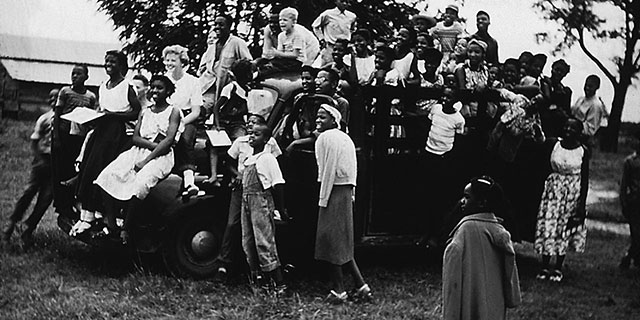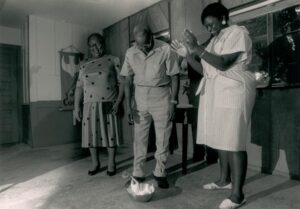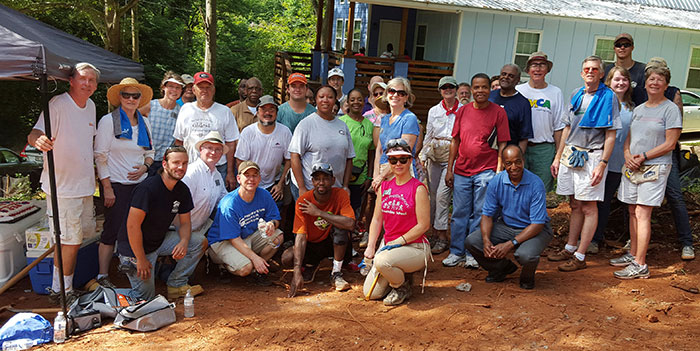
It was in the early 1930s when a UGA College of Agriculture student named Clarence Jordan, fed up with the racism and economic oppression he saw all around him, had a vision which would lead to the founding of Koinonia Farms in Sumter County, GA, in 1942. It was a community where all were welcome, and people of different ethnicities broke bread together.
“Even though people about us choose the path of hate and violence and warfare and greed and prejudice,” Jordan wrote, “we… must throw off these poisons and let love permeate and cleanse every tissue and cell. Nor are we to allow ourselves to become easily discouraged when love is not always obviously successful or pleasant.”

Farmers living at Koinonia were innovative, experimenting with new farming methods and technologies to boost yields, and the 400 acre community started seeing some success, despite sometimes violent opposition from their neighbors who cut their trees down, sabotaged their equipment, and even attacked them with guns and explosives. By the 1950s, Koinonia was shipping pecans around the country and even the world, without one single customer in its home county.
By the ’60s, though, the farm had dwindled, in part due to the local violence and discrimination. (Even White children from Koinonia were denied admission to schools in Americus.) Some of the property’s homes became way stations for civil rights workers visiting the area, and the organization’s focus shifted more toward supporting voting rights and economic opportunity.
By 1964, while still in their 20s, Linda and Millard Fuller had become millionaires by selling home and farm goods through mail-order out of Montgomery, AL. But they discovered that money didn’t fulfill them. So they ditched that lifestyle entirely and, after meeting Clarence Jordan through a mutual friend, moved onto the land in Sumter County in ’67.
Millard was fascinated by the notion of the “fund for humanity” which Clarence had first conceived of during his college days. Together, the Jordans and the Fullers transformed Koinonia Farms into Koinonia Partners, an organization dedicated to ending discrimination in housing by putting people into homes they own.
Despite court rulings demanding desegregation, housing in the US in the 1960s remained firmly divided. And in this case, as usual, separate was not equal.
Just as Black farmers had found themselves excluded from government assistance programs in the 1800s and 1930s, Black soldiers had been largely locked out of the benefits of the G.I. Bill which helped White families all over America become homeowners in the wake of World War II. Informally, “redlining” — that is, White people simply refusing to show or sell or finance homes in White neighborhoods to non-White buyers — was so ubiquitous that it had to be federally outlawed in 1968, although the practice would continue for decades afterward. It was this disparity which sparked the mission of Koinonia Partners.
“There was a stark divide between the quality of Black housing and White housing at the time, even if they earned the same,” Jordan’s son Lenny recalls. “And housing affects everything you do in life…. All of Koinonia put a ton of energy behind it because it was a way to improve lives, improve equality — both right away and over the long run.”
The idea behind the new venture was pretty simple — build homes at cost, using volunteer labor when practical, and sell them with zero-interest mortgages to families who couldn’t find decent affordable housing on the for-profit market. Payments on those mortgages went into the fund for humanity, enabling the organization to pay the up-front costs for more homes. In 1969 Clarence Jordan passed away — Millard had to drive the body to the coroner’s office because the coroner refused to set foot on Koinonia’s integrated property — and it was up to the Fullers to continue the work.
Two weeks after Jordan’s death, Koinonia Partners’ first home was completed. Within the next two years, twenty-six more were constructed as the “partnership housing” program attracted a wave of volunteers along with trade workers in support fields, also reviving the farm business. It was clear, they were onto something big.
In 1976, the Fullers moved from the farm to the county seat of Americus, GA, where they founded Habitat for Humanity International, using the model they’d developed at Koinonia. That same year, a local farmer who supported the Fullers’ work, a Navy veteran named Jimmy Carter, was elected President of the US. As he and his wife Rosalynn continued to volunteer on build sites, Habitat became a household name in America.

During the 1980s, Habitat affiliates were established countrywide, including Athens Area Habitat for Humanity in August of ’88. Groundbreaking for our first home at Second and Pearl streets was celebrated by an 11-week, 1200 mile walk from Portland, Maine, to Athens, culminating in a $2-a-plate supper at Lake Herrick hosted by Millard Fuller. The banner carried by the walkers now hangs in our Barber Street office.
Home #2 was donated by Athens Regional Medical Center and moved from Pine Needle and Talmadge, down Prince Avenue, to Peter Street. In 1990, Athens Area Habitat’s first home in Oconee County, its fourth overall, was constructed.
The following year, we completed our first house in Oglethorpe County near Sandy Cross, as well as our first access ramp installation, in Lexington, for a disabled homeowner. The ramp project led to the Small Projects Group collaboration, which eventually grew into the current Brush With Kindness (a multi-affiliate Habitat program) and AIM programs which help low-income homeowners in Clarke County with basic repairs and disability modifications.
In November of 1992, we opened The Attic in a barn behind our affiliate location at Barber and Tracy streets, making Athens the third market, behind Winnipeg (Manitoba) and Austin (Texas), to raise funds with an affilate-operated thrift store. (The miniature “barn door” above the entry to the current Barber Street store is a nod to that original location.) In its first year, The Attic raised $15,000.

Together with the affiliate office and barn, the original Barber Street property included two homes, which were the first cost-manageable rental properties operated by the affiliate, a program spearheaded in Athens which went national through HFHI in 2019. Within just 5 years, largely driven by the leadership of Bill Baggs, Athens Area Habitat had built 10 houses, opened a retail store, begun a disability modifications program and a home repair program, and pioneered low-income rental housing programs for Habitat in America, making it one of the most innovative affiliates in the nation.
In 1994, the UGA Habitat chapter was founded, and in ’97 it completed its first house project under the leadership of Robyn Painter. As one of only two students chosen to attend the first Jimmy Carter Work Project in Eastern Europe — a large “blitz” build, completing 10 houses in a week — Painter’s experience and drive were instrumental in getting the UGA chapter off the ground.
By our tenth anniversary, Athens Area Habitat had completed 24 homes, and the 25th and 26th houses were underway. It was a time when the affiliate was ramping up the pace of construction, and by October of 2001 thirty-five homes had been constructed and an additional eight were in progress, six in Clarke County and two in Oglethorpe.
The early 2000s saw a shift in focus from constructing individual homes on unconnected lots to building micro-subdivisions and pocket neighborhoods. During this period the Dorsey Village and Carpenter’s Circle neighborhoods were completed in Clarke County. In 2013, during our 25th anniversary month, we opened our second ReStore in Athens, making us the first Georgia affiliate to operate a two-store system.
The twenty-teens brought an expansion of investment in cost-manageable rentals through our ReNew Athens program which purchases abandoned multi-family housing for renovation. The Foundation on Broad was our first apartment complex, while renovation on Simmons Street and Magnolia Terrace rehabbed duplexes and quadruplexes.
An offshoot partnership with Lydia’s Place also brought about our first project aimed at housing the homeless. The result was Lydia’s Homeplace, a managed multi-unit home for young adults coming from a background of homelessness who’ve earned acceptance into area colleges and universities. That effort was followed by a partnership with Family Promise of Athens to create transitional housing for families whom they help to recover from homelessness.
When covid hit in 2020 we were forced to suspend our regular operations for a time, but shifted into other projects such as support for a mobile testing clinic and producing human-safe sanitizer for county agencies, which we also used in our stores once they reopened. After getting back on our feet we were able to complete our Kinda Tiny Homes — silver LEED certified houses with footprints under 1000 ft2, powered in part by rooftop solar arrays — as well as our “Build with Strength” house, constructed with insulating concrete forms (ICFs) for unmatched resilience, quiet, and energy efficiency.
Our most recent and most ambitious project is Micah’s Creek, an 11-acre neighborhood plus satellite lots comprising more than five dozen homes, including single family houses for families in the Gaines Elementary attendance zone, tiny homes for veterans and artists, and two-bedroom bungalows to be managed by Lydia’s Place. Accompanying this project is a longitudinal study by UGA to determine the impact of home ownership on students’ educational achievement.
We’ve come a long way since Clarence Jordan sat in that UGA classroom nearly a century ago, wondering what he could do to improve lives and combat racial bigotry in his home state. A lot has been accomplished since, but one thing we know: We have not yet done all we can do. There is still more work, more innovation, more partnerships ahead. And until the day comes when our mission is fulfilled and we are no longer needed, we intend to keep moving forward with hope, determination, and most of all, love.
